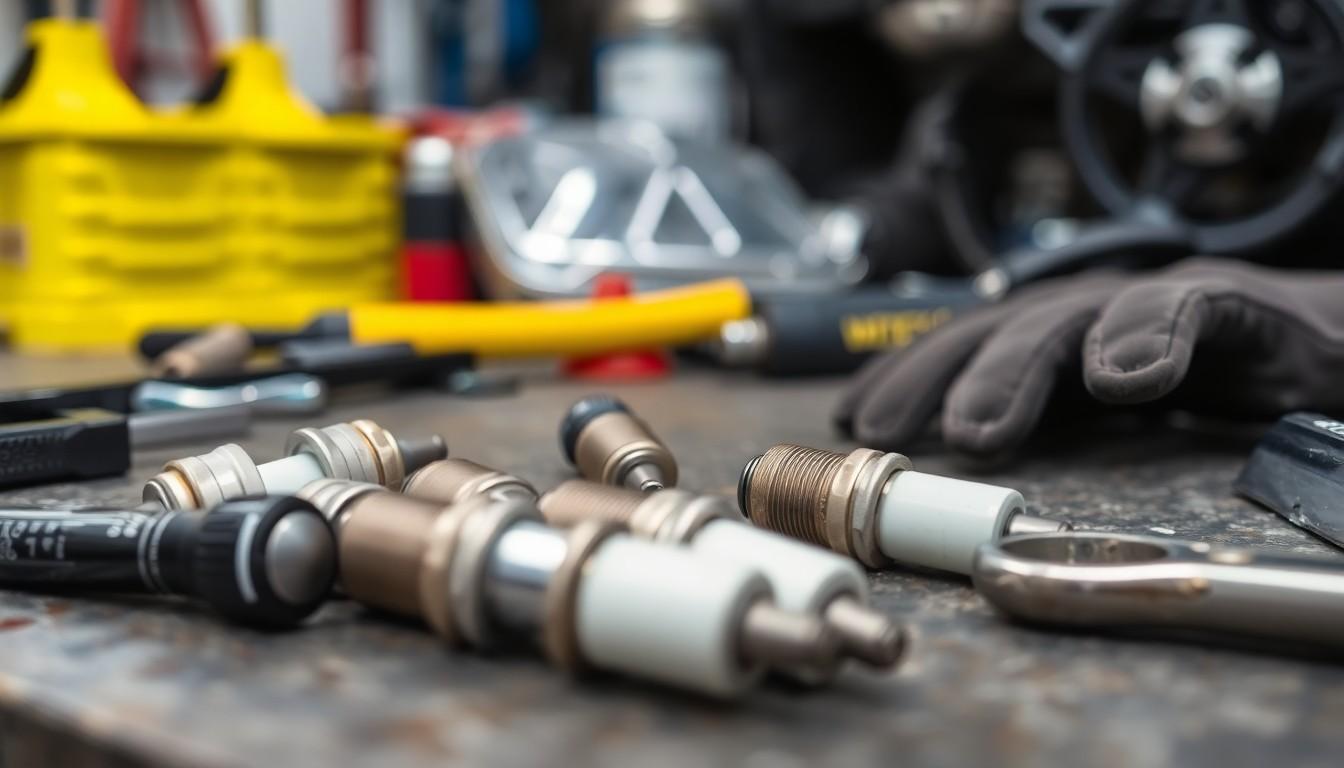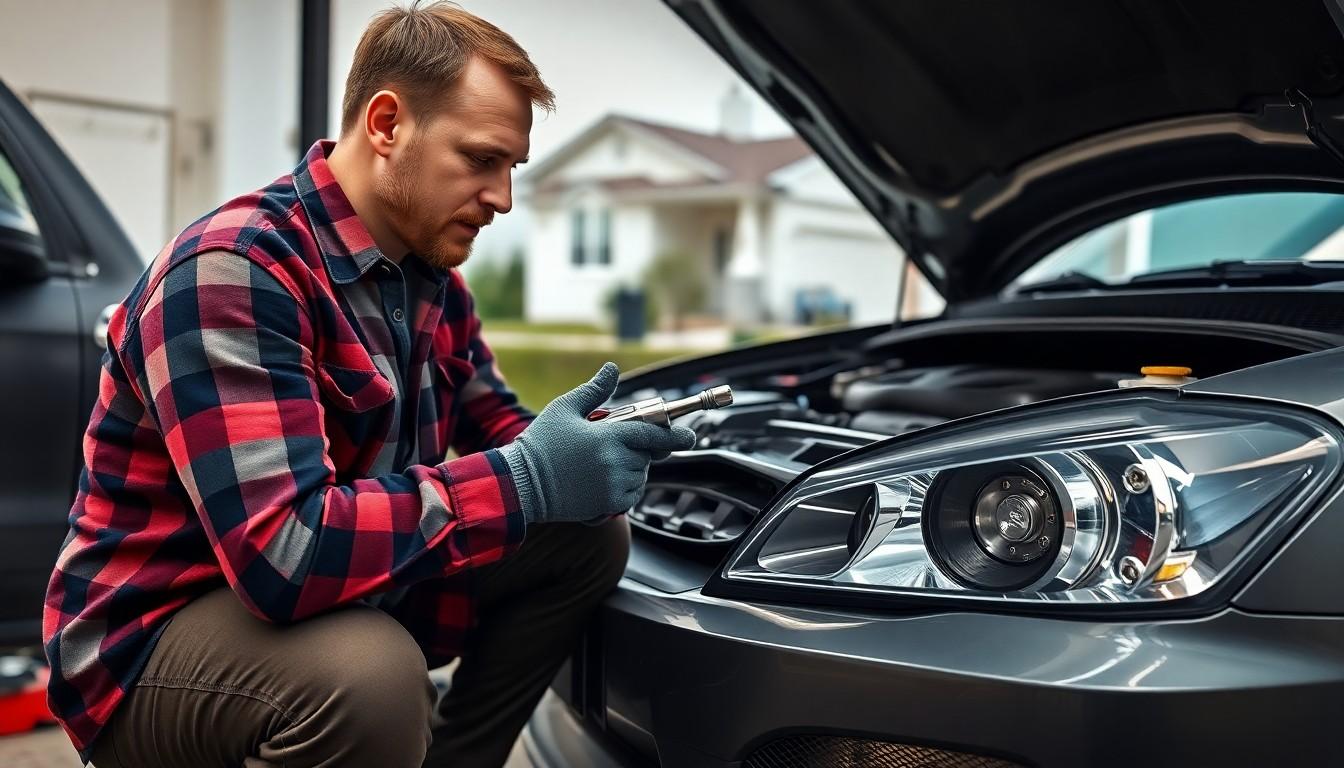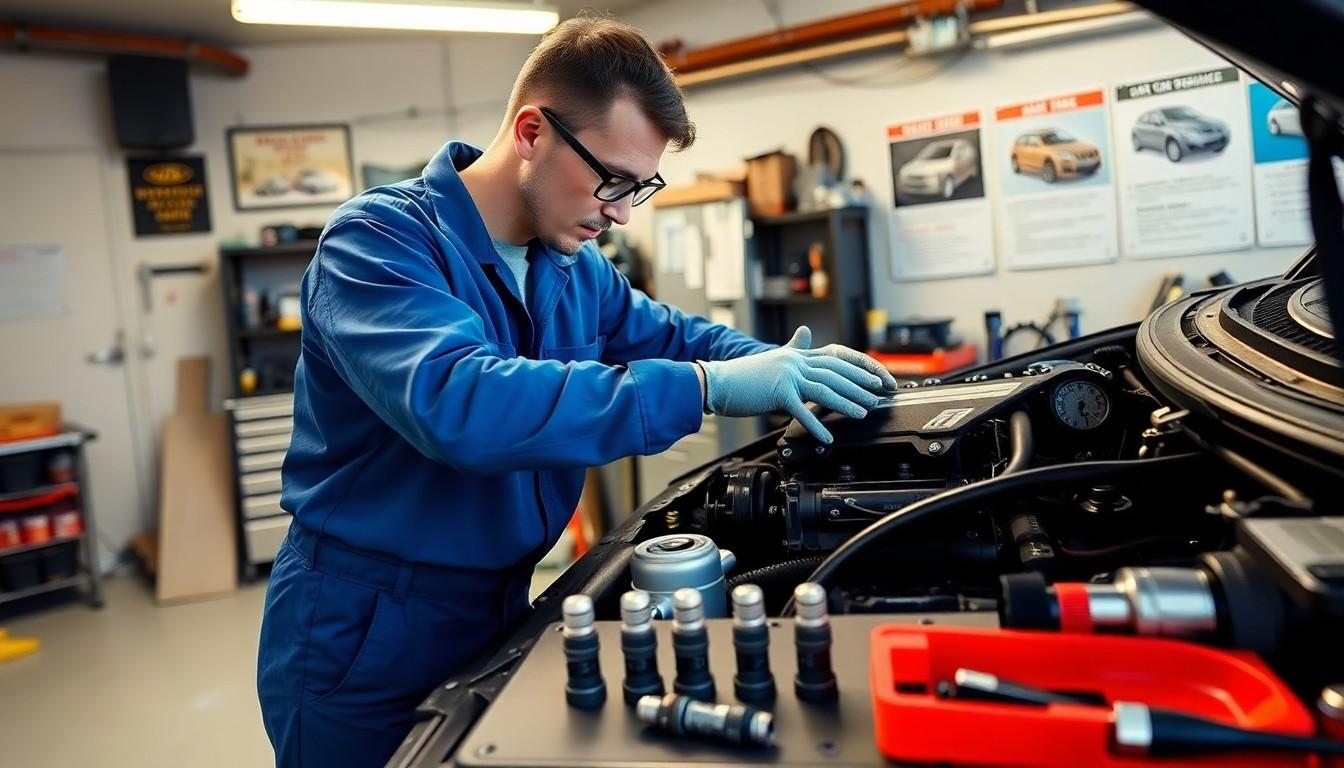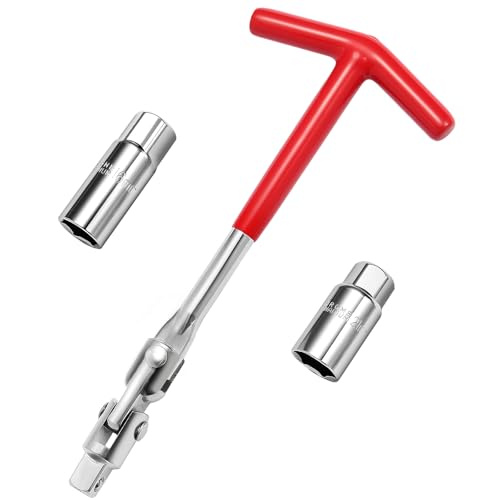Wondering if you can tackle spark plug replacement on your own? We’ve got good news – replacing spark plugs is one of the most approachable DIY car maintenance tasks that can save you important money at the mechanic.
With basic tools and a little guidance, most car owners can successfully replace their vehicle’s spark plugs in under an hour. Not only will you feel accomplished after completing this essential maintenance job, but you’ll also potentially improve your car’s performance, fuel efficiency, and engine reliability. We’ll walk you through everything you need to know to get the job done right.
Why Replacing Your Own Spark Plugs Makes Sense
Replacing your own spark plugs offers important cost savings compared to professional service. The average mechanic charges $150-$200 for a standard spark plug replacement, while DIY parts typically cost only $20-$50 for a set of quality plugs. These financial benefits add up quickly, especially for vehicles requiring more frequent replacements.
DIY spark plug replacement provides an educational experience that enhances your understanding of how your engine operates. Learning this fundamental maintenance task builds confidence for tackling other car repairs and helps you identify potential issues before they become serious problems.
The convenience factor can’t be overlooked when considering self-replacement. Scheduling around a mechanic’s availability often means losing your vehicle for hours or even a full day. By handling this task yourself, you can complete the work on your own schedule—whether that’s early morning, evening, or weekend hours when most shops are closed.
Regular spark plug maintenance improves vehicle performance in measurable ways. Fresh plugs create more efficient combustion, resulting in smoother acceleration, reduced emissions, and better fuel economy by up to 30% in some vehicles. Taking ownership of this maintenance ensures it’s done on the optimal schedule for your exact driving conditions.
The satisfaction of successfully completing your own repairs shouldn’t be underestimated. Many car owners report feeling empowered after their first DIY spark plug replacement, with 85% indicating they’re more likely to attempt additional maintenance tasks in the future. This growing mechanical confidence translates to greater automotive independence and reduced reliance on paid services.
Tools You’ll Need for DIY Spark Plug Replacement

Replacing spark plugs yourself requires a exact set of tools to ensure the job is done correctly and safely. Having the right equipment makes the difference between a smooth replacement process and potential frustration or damage to your vehicle.
Basic Tools Every DIYer Should Have
Every spark plug replacement project starts with essential tools that form the foundation of your DIY toolkit. A spark plug socket (typically 5/8 inch or 13/16 inch) with an interior rubber gasket protects the ceramic portion of the plug during installation. This specialized socket must be paired with a ratchet and extension to access the plugs, especially those located deep within the engine compartment. Safety equipment like gloves and protective eyewear shields you from potential electrical hazards and debris. Most DIYers also need a spark plug gapping tool to adjust the electrode spacing according to manufacturer specifications. Battery disconnect tools prevent accidental short circuits during the replacement process. For removing spark plug wires or coil-on-plug connectors, an HT or ignition lead puller proves invaluable in preventing damage to these components.
Optional Specialized Tools That Help
Several specialized tools can significantly enhance your spark plug replacement experience beyond the basics. A torque wrench ensures precise tightening of new plugs to manufacturer specifications, preventing damage from over-tightening. Cleaning tools eliminate dirt and debris from spark plug holes before installing new plugs, maintaining engine efficiency. COP (coil-on-plug) removal tools make extracting these components safer and easier, particularly in tight engine compartments. Spark plug wire pullers provide better grip and control when disconnecting wires from older vehicles, reducing the risk of damaging the wire boots. A compression gauge, while not directly needed for replacement, helps diagnose related engine performance issues that might accompany faulty spark plugs. Work lights illuminate dark areas of the engine bay, making the job easier in poorly lit garages or during evening repairs. For vehicles with difficult-to-access plugs, jack stands and a quality floor jack provide safe undercarriage access when necessary.
Signs It’s Time to Replace Your Spark Plugs

Recognizing when your spark plugs need replacement helps prevent more serious engine problems down the road. Several performance indicators signal worn-out spark plugs that require attention.
Engine Misfiring
Engine misfiring presents one of the most common symptoms of failing spark plugs. You’ll notice your engine running roughly, stumbling, or hesitating during acceleration. This occurs because worn spark plugs can’t effectively ignite the fuel-air mixture in the combustion chamber, resulting in incomplete combustion.
Loss of Power
Decreased engine performance manifests when spark plugs deteriorate over time. Your car might feel sluggish, especially when accelerating or climbing hills. This power reduction happens because degraded spark plugs fail to produce the strong, consistent spark necessary for optimal combustion, leading to reduced engine output.
Increased Fuel Consumption
Fuel economy suffers significantly with failing spark plugs. You’ll observe your vehicle requiring more frequent refueling trips than normal. Poor spark plug performance forces your engine to work harder and use more fuel to generate the same power, directly impacting your wallet at the gas pump.
Hard Starts
Starting difficulties often indicate spark plug issues. Your engine may crank longer before starting or require multiple attempts to turn over. This happens because worn spark plugs can’t create a strong enough spark to initiate combustion effectively, particularly during cold weather or when the engine hasn’t been run recently.
By monitoring these key indicators, you can identify spark plug problems early and address them before they lead to more extensive engine damage or leave you stranded. Regular inspection of your spark plugs saves money and helps maintain your vehicle’s performance and reliability.
Step-by-Step Guide to Replacing Spark Plugs Yourself

Replacing spark plugs is a straightforward DIY maintenance task that anyone with basic tools can accomplish. Follow our comprehensive guide below to successfully change your spark plugs and improve your vehicle’s performance.
Preparing Your Vehicle
Proper preparation ensures a smooth spark plug replacement process. Gather essential tools including a spark plug socket (typically 5/8 inch or 13/16 inch), a ratchet with extensions, a rubber interior gasket, and a spark plug gapping tool. Always work with a completely cool engine to avoid burns and potential thread damage during removal or installation. Disconnect the battery terminals before beginning to prevent accidental short circuits while working on the electrical components.
Accessing the Spark Plugs
Locating and accessing spark plugs varies by vehicle model but follows similar principles. Find the spark plugs positioned on the side of the engine or near the cylinder head, which may require removing engine covers or air intake ducts for clear access. Carefully detach the spark plug wires using a dedicated wire puller tool or disconnect the coil-on-plug connectors depending on your vehicle’s ignition system. Label each wire or connector to ensure correct reinstallation order and avoid engine performance issues.
Removing Old Spark Plugs
Extraction of old spark plugs requires attention to detail and proper technique. Attach your spark plug socket to the ratchet, ensuring the rubber insert is in place to grip the spark plug securely. Position the socket over the spark plug and turn counterclockwise to loosen and remove it completely. Inspect each removed plug for signs of engine problems such as oil fouling, carbon deposits, or electrode erosion. Clean the spark plug hole thoroughly to remove any dirt or debris that could contaminate the cylinder when installing new plugs.
Installing New Spark Plugs
Installation of new spark plugs demands precision to achieve optimal engine performance. Check that your replacement plugs match the manufacturer’s specifications and verify the electrode gap using your gapping tool. Insert each new spark plug by hand into its respective cylinder hole, turning clockwise until finger-tight to prevent cross-threading. Complete the installation by using your spark plug socket to tighten an additional 1/8 to 1/4 turn beyond finger-tight—overtightening can damage the threads or the plug itself. Reconnect all spark plug wires or coil-on-plug connectors in their correct positions, then reattach the battery terminals to complete the job.
Common Mistakes to Avoid During Replacement

DIY spark plug replacement can go wrong when exact errors are made. Understanding these potential pitfalls helps ensure a successful maintenance job without damaging your vehicle.
Over-Tightening
Over-tightening spark plugs damages the delicate threads in your cylinder head. Always hand-tighten new spark plugs first, then use a socket wrench to add only an eighth to a quarter turn until snug. Forcing the plug too tight creates expensive repair situations requiring cylinder head removal or thread repair.
Damaging COP Boots
Coil-On-Plug (COP) boots protect vital electrical connections. Twisting gently breaks the seal before pulling straight up on the coil to remove it. Torn or cracked insulator boots cause high voltage leaks and engine misfires. Inspect boots carefully during removal and replacement to ensure they remain intact.
Not Ensuring a Cool Engine
Hot engines pose serious safety risks during spark plug replacement. Burns from heated components occur frequently when attempting this job on a recently running vehicle. Also, removing plugs from a hot engine can damage cylinder head threads due to thermal expansion. Allow your engine to cool completely before beginning work.
Not Disconnecting the Battery
Battery disconnection prevents electrical mishaps. Failing to disconnect your battery terminals can result in short circuits, computer damage, or accidental ignition system activation. Taking the extra minute to disconnect the negative terminal first creates a much safer working environment.
Using Incorrect Tools
Proper tools make spark plug replacement significantly easier. Using the wrong socket size (common sizes are 5/8 inch and 13/16 inch) leads to stripped plug heads and frustrating removals. A dedicated spark plug socket with an interior rubber gasket protects the ceramic insulator and provides better grip. Spark plug gapping tools ensure proper electrode spacing for optimal performance.
Not Cleaning the Spark Plug Hole
Debris falling into cylinders causes immediate engine damage. Clean around each spark plug hole thoroughly before removal to prevent dirt from entering the combustion chamber. Compressed air works effectively to blow away debris, while a clean rag helps wipe surfaces around the plug. Thorough cleaning prevents potential engine knocking, misfires, or cylinder scoring.
When to Call a Professional Instead

DIY spark plug replacement isn’t always the best option for every vehicle owner. Certain situations call for professional expertise to ensure your engine’s health and safety.
Lack of Experience or Confidence
First-time DIY mechanics often struggle with confidence when working on their vehicles. If you’re unsure about any aspect of the spark plug replacement process, it’s better to consult a professional mechanic. Mechanical errors during installation can lead to stripped threads, broken plugs, or damaged ignition components. Professionals have the experience to handle these potential complications and prevent costly repairs down the road.
Complex Engine Design
Modern vehicles feature increasingly complex engine layouts that complicate spark plug access. Some manufacturers design engines with spark plugs tucked beneath intake manifolds or behind other components. These designs often require specialized tools and technical knowledge beyond the average DIY toolkit. Many luxury brands and newer models with turbocharged engines present particular challenges that professionals are equipped to handle efficiently.
Additional Issues
Spark plug problems rarely exist in isolation. During inspection, you might notice damaged spark plug wires, faulty ignition coils, or corroded electrodes that indicate deeper engine issues. These complications require diagnostic expertise that extends beyond simple parts replacement. Professional mechanics can identify underlying problems that might go unnoticed during a DIY job, preventing potential engine damage and performance issues.
Time Constraints
Spark plug replacement typically takes 30-60 minutes for experienced DIYers, but first-timers might need several hours. Tight schedules or limited garage access may make professional service more practical. Professional mechanics can complete the job quickly with their specialized tools and experience. Their efficiency often justifies the additional cost when time is a critical factor in your decision.
Cost Comparison: DIY vs. Professional Replacement

Parts Cost
DIY spark plug replacement significantly reduces expenses compared to professional services. Spark plugs themselves range from $10 to $100 per set, varying based on the type and number of cylinders in your engine. Higher-end iridium or platinum plugs cost more than standard copper plugs but offer longer lifespans and better performance. For a four-cylinder engine, a complete set of quality spark plugs typically costs $20-$50, making the parts investment quite reasonable for most vehicle owners.
Labor Savings
Professional mechanics charge between $181 and $265 for labor when replacing spark plugs, representing the bulk of service costs. This labor expense is completely eliminated when you perform the replacement yourself. The total professional service ranges from $270 to $381 including both parts and labor, while DIY costs remain limited to just the price of the spark plugs and any tools you might need to purchase. Vehicle-exact costs vary considerably – Ford F-150 owners face professional replacement bills of $330-$437, while Toyota Camry owners pay between $151-$215.
Tool Investment
Completing a DIY spark plug replacement requires several exact tools:
- Gap gauge for precise spark plug gap measurement
- Needle-nose pliers for wire handling
- Socket or ratchet set with spark plug socket
- Spark plug wire puller to prevent wire damage
- Swivel socket for hard-to-reach plugs
- Torque wrench for proper tightening
Many car owners already possess most of these tools, making the initial investment minimal. Even purchasing all necessary tools costs less than a single professional spark plug replacement service, and these tools remain useful for future maintenance tasks.
Time Consideration
DIY spark plug replacement typically takes about an hour for a four-cylinder engine with easily accessible plugs. Complex engine configurations or difficult-to-reach plugs can extend this timeframe significantly. Professional mechanics, with their experience and specialized tools, often complete the job more quickly. The time investment becomes an important factor when weighing the roughly $200 labor savings against your own schedule constraints and comfort level with automotive work.
Conclusion
Replacing spark plugs yourself is definitely within reach for most car owners with basic mechanical skills. We’ve seen how this simple DIY task can save you $150-200 while improving engine performance and fuel efficiency.
With just a few tools and about an hour of your time you can successfully complete this maintenance job on your own schedule. The satisfaction of handling this repair yourself builds confidence for future car projects too.
Remember to watch for warning signs like misfiring or hard starts that indicate it’s time for new plugs. While DIY is often the smart choice some complex engine designs or lack of experience might warrant professional help.
By taking on this accessible maintenance task you’re not just saving money but gaining valuable knowledge about how your vehicle operates.
Frequently Asked Questions
How often should I replace my spark plugs?
Most manufacturers recommend replacing spark plugs every 30,000 to 100,000 miles, depending on your vehicle model and the type of spark plugs installed. Standard copper plugs typically need replacement more frequently (30,000-50,000 miles), while platinum or iridium plugs can last longer (60,000-100,000 miles). Always check your owner’s manual for the recommended interval specific to your car.
What tools do I need to replace spark plugs?
You’ll need a spark plug socket (sized appropriately for your vehicle), ratchet and extensions, torque wrench, gap tool, anti-seize compound, dielectric grease, safety glasses, and gloves. Having a service manual or online guide specific to your vehicle is also helpful. Most of these tools are affordable and will pay for themselves after just one DIY spark plug replacement.
How much money can I save by replacing spark plugs myself?
DIY spark plug replacement can save you $100-$150 or more. Professional services typically cost $150-$200, while doing it yourself only requires spending $20-$50 on parts. For a standard 4-cylinder engine, a set of quality spark plugs costs between $10-$100 depending on the type (copper, platinum, or iridium), making this one of the most cost-effective DIY maintenance tasks.
How do I know when my spark plugs need replacing?
Watch for signs like engine misfiring (rough idling, stuttering acceleration), decreased fuel efficiency (10-20% drop), difficulty starting the vehicle, and loss of power when accelerating. Other indicators include a check engine light, engine hesitation, and rough engine performance. Regular inspection during routine maintenance can also help identify worn spark plugs before they cause performance issues.
Can I damage my engine if I replace spark plugs incorrectly?
Yes, improper spark plug installation can damage your engine. Common mistakes include cross-threading (forcing the plug at the wrong angle), over-tightening (which can strip threads or crack porcelain insulators), and under-tightening (causing plugs to blow out). Also, dropping debris into the cylinder can cause serious internal damage. Following proper procedures and using the correct torque specifications is essential.
How long does it take to replace spark plugs?
For most vehicles, DIY spark plug replacement takes 30-60 minutes for a first-timer, and as little as 20-30 minutes with experience. The time varies based on engine design and accessibility. V-shaped engines or those with complex covers may take longer. Professional mechanics typically complete the job in 30 minutes or less due to their experience and specialized tools.
Do I need to gap new spark plugs before installation?
Most modern spark plugs come pre-gapped from the factory, but it’s still important to verify the gap with a gap tool before installation. Check your vehicle’s manual for the correct gap specification. If adjustment is needed, carefully bend the electrode using a gapping tool until the proper measurement is achieved. Improper gaps can cause poor engine performance and reduced fuel economy.
When should I hire a professional instead of DIY?
Consider professional help if you lack confidence or mechanical experience, own a vehicle with a complex engine design (especially luxury or high-performance cars), suspect underlying engine problems beyond spark plug issues, or face significant time constraints. Professionals have specialized tools and diagnostics equipment that can identify additional problems that might not be apparent during a simple spark plug change.
What type of spark plugs should I buy for my car?
Always follow manufacturer recommendations found in your owner’s manual. Copper plugs are least expensive but have shorter lifespans. Platinum and double-platinum plugs offer better durability and performance. Iridium plugs are premium options with the longest lifespan and best performance. Using the wrong type can lead to poor engine performance and potential damage.
Is it safe to replace spark plugs on my own?
Yes, replacing spark plugs is generally safe if you follow proper procedures. Always ensure the engine is cool before starting, disconnect the battery to prevent electrical shorts, use the correct tools to avoid injuries, and work in a well-ventilated area. Wear safety glasses to protect your eyes from debris and follow the manufacturer’s torque specifications to prevent damage.











